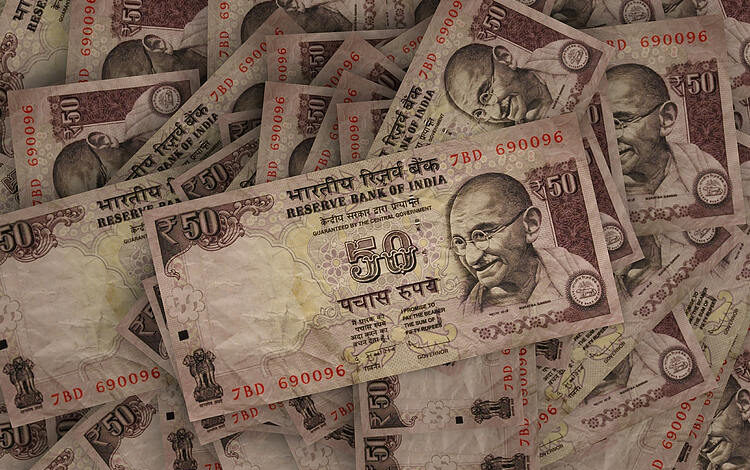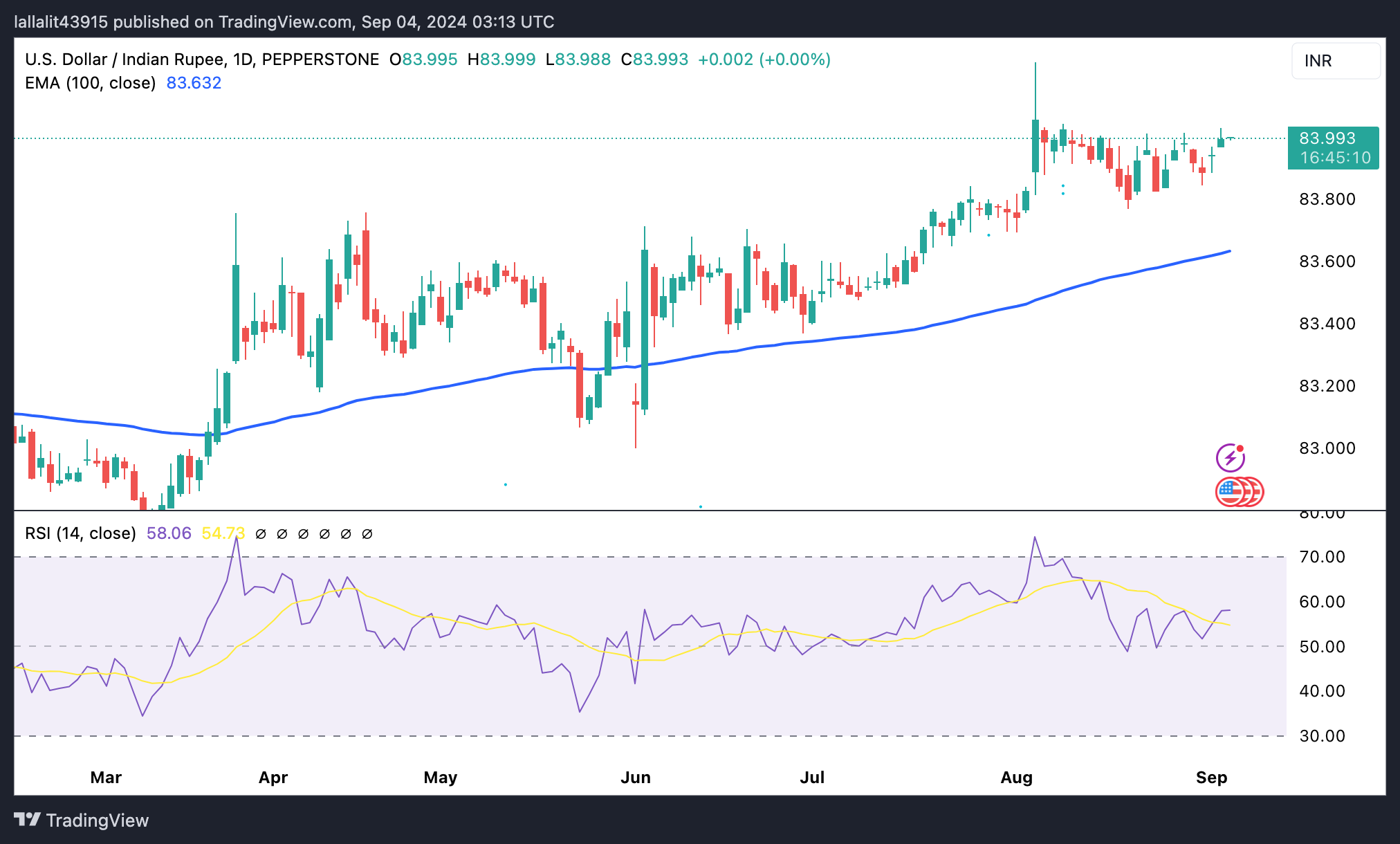USD/INR flat lines ahead of India PMI data

- Indian Rupee trades flat in Wednesday’s Asian trading hours.
- Possible RBI interventions and lower crude oil prices might support the INR, while firmer USD could limit its upside.
- Investors await the HSBC India Services PMI on Wednesday for fresh impetus.
The Indian Rupee (INR) holds steady on Wednesday. Traders remain vigilant for potential interventions from the Reserve Bank of India (RBI) to prevent the INR from breaching the 84 mark, though this has yet to be officially confirmed. Meanwhile, a fall in crude oil prices to the lowest since January might underpin the local currency as India is the world’s third-largest oil-consuming and importing nation.
Nonetheless, the renewed demand for the US Dollar (USD) from importers and risk aversion could weigh on the INR and boost the safe-haven currency like the Greenback. Looking ahead, the HSBC India Services Purchasing Managers Index (PMI) is due on Wednesday. On the US docket, JOLTS Job Openings and Fed Beige Book will be published. The attention will shift to the US Nonfarm Payrolls (NFP) for August on Friday, which might offer some hints about the size and pace of rate cuts by the Federal Reserve (Fed) this year.
Daily Digest Market Movers: Indian Rupee remains fragile amid multiple headwinds
- The World Bank has raised India’s growth forecast to 7% for the current financial year (FY25), up from an earlier projection of 6.6%.
- The RBI Deputy Governor Michael Patra said India will need rapid economic growth for a decade in order to achieve Prime Minister Narendra Modi’s goal of becoming a developed country by 2047.
- HSBC India Services PMI is expected to improve to 60.4 in August from 60.3 in July.
- The business activity in the US manufacturing sector continued to contract, albeit at a softer pace in August. The US ISM Manufacturing PMI rose to 47.2 in August versus 46.8 prior, weaker than expected.
- Financial markets have priced in around 61% odds of a 25 basis points (bps) rate cut by the Fed in September, while the possibility of a 50 bps reduction stands at 39%, according to the CME FedWatch tool.
Technical Analysis: USD/INR is in consolidative mode, a longer-term bullish outlook remains in play
The Indian Rupee trades weaker on the day. The USD/INR pair remains traded in a consolidative mode in the near term. However, in the longer term, the positive view of the pair prevails as the price is well-supported above the key 100-day Exponential Moving Average (EMA) on the daily timeframe, with the 14-day Relative Strength Index (RSI) standing in bullish territory near 58.0.
The 84.00 psychological figure appears to be a tough nut to crack for USD/INR. A decisive break above this level could pave the way to 84.50.
In the bearish event, the initial support level emerges at 83.84, the low of August 30. A breach of the mentioned level could lead to some downside, possibly dragging the pair lower to the 100-day EMA at 83.62.
Indian Rupee FAQs
The Indian Rupee (INR) is one of the most sensitive currencies to external factors. The price of Crude Oil (the country is highly dependent on imported Oil), the value of the US Dollar – most trade is conducted in USD – and the level of foreign investment, are all influential. Direct intervention by the Reserve Bank of India (RBI) in FX markets to keep the exchange rate stable, as well as the level of interest rates set by the RBI, are further major influencing factors on the Rupee.
The Reserve Bank of India (RBI) actively intervenes in forex markets to maintain a stable exchange rate, to help facilitate trade. In addition, the RBI tries to maintain the inflation rate at its 4% target by adjusting interest rates. Higher interest rates usually strengthen the Rupee. This is due to the role of the ‘carry trade’ in which investors borrow in countries with lower interest rates so as to place their money in countries’ offering relatively higher interest rates and profit from the difference.
Macroeconomic factors that influence the value of the Rupee include inflation, interest rates, the economic growth rate (GDP), the balance of trade, and inflows from foreign investment. A higher growth rate can lead to more overseas investment, pushing up demand for the Rupee. A less negative balance of trade will eventually lead to a stronger Rupee. Higher interest rates, especially real rates (interest rates less inflation) are also positive for the Rupee. A risk-on environment can lead to greater inflows of Foreign Direct and Indirect Investment (FDI and FII), which also benefit the Rupee.
Higher inflation, particularly, if it is comparatively higher than India’s peers, is generally negative for the currency as it reflects devaluation through oversupply. Inflation also increases the cost of exports, leading to more Rupees being sold to purchase foreign imports, which is Rupee-negative. At the same time, higher inflation usually leads to the Reserve Bank of India (RBI) raising interest rates and this can be positive for the Rupee, due to increased demand from international investors. The opposite effect is true of lower inflation.
Information on these pages contains forward-looking statements that involve risks and uncertainties. Markets and instruments profiled on this page are for informational purposes only and should not in any way come across as a recommendation to buy or sell in these assets. You should do your own thorough research before making any investment decisions. FXStreet does not in any way guarantee that this information is free from mistakes, errors, or material misstatements. It also does not guarantee that this information is of a timely nature. Investing in Open Markets involves a great deal of risk, including the loss of all or a portion of your investment, as well as emotional distress. All risks, losses and costs associated with investing, including total loss of principal, are your responsibility. The views and opinions expressed in this article are those of the authors and do not necessarily reflect the official policy or position of FXStreet nor its advertisers. The author will not be held responsible for information that is found at the end of links posted on this page.
If not otherwise explicitly mentioned in the body of the article, at the time of writing, the author has no position in any stock mentioned in this article and no business relationship with any company mentioned. The author has not received compensation for writing this article, other than from FXStreet.
FXStreet and the author do not provide personalized recommendations. The author makes no representations as to the accuracy, completeness, or suitability of this information. FXStreet and the author will not be liable for any errors, omissions or any losses, injuries or damages arising from this information and its display or use. Errors and omissions excepted.
The author and FXStreet are not registered investment advisors and nothing in this article is intended to be investment advice.
Editors’ Picks
USD/JPY holds the rebound near 145.50 despite risk-off flows
USD/JPY is trying hard to sustain the bounce near 145.50 in Asian trading on Wednesday, as the US Dollar keeps losses even though risk sentiment sours amid concerns over a potential US ‘soft-landing’. Japanese verbal warnings fail to move the pair, as the focus shifts to US jobs data.
Moneta Markets review 2024: All you need to know
VERIFIED In this review, the FXStreet team provides an independent and thorough analysis based on direct testing and real experiences with Moneta Markets – an excellent broker for novice to intermediate forex traders who want to broaden their knowledge base.






